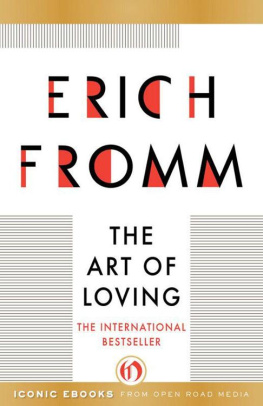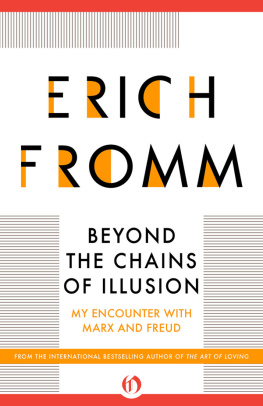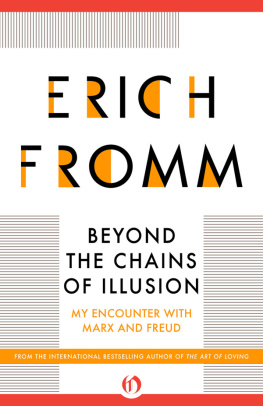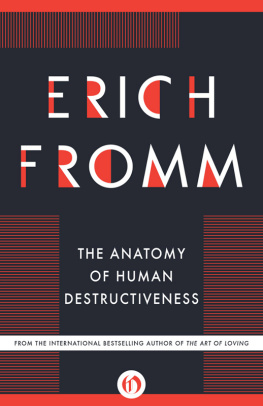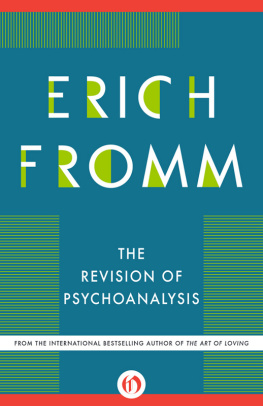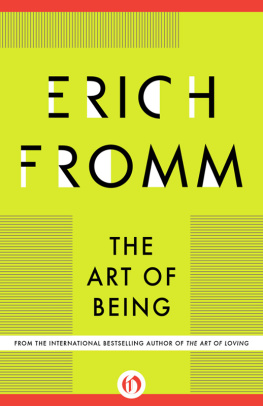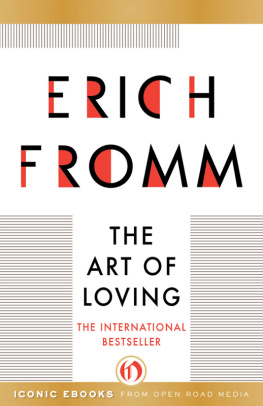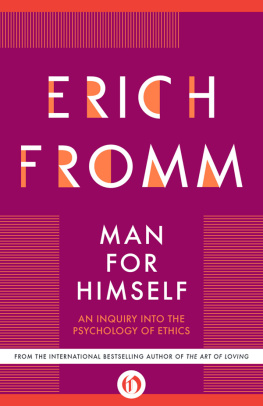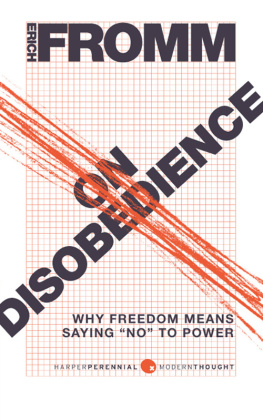Erich Fromm - The Art of Loving
Here you can read online Erich Fromm - The Art of Loving full text of the book (entire story) in english for free. Download pdf and epub, get meaning, cover and reviews about this ebook. year: 1956, publisher: Open Road Media, genre: Science. Description of the work, (preface) as well as reviews are available. Best literature library LitArk.com created for fans of good reading and offers a wide selection of genres:
Romance novel
Science fiction
Adventure
Detective
Science
History
Home and family
Prose
Art
Politics
Computer
Non-fiction
Religion
Business
Children
Humor
Choose a favorite category and find really read worthwhile books. Enjoy immersion in the world of imagination, feel the emotions of the characters or learn something new for yourself, make an fascinating discovery.
- Book:The Art of Loving
- Author:
- Publisher:Open Road Media
- Genre:
- Year:1956
- Rating:3 / 5
- Favourites:Add to favourites
- Your mark:
- 60
- 1
- 2
- 3
- 4
- 5
The Art of Loving: summary, description and annotation
We offer to read an annotation, description, summary or preface (depends on what the author of the book "The Art of Loving" wrote himself). If you haven't found the necessary information about the book — write in the comments, we will try to find it.
The Art of Loving — read online for free the complete book (whole text) full work
Below is the text of the book, divided by pages. System saving the place of the last page read, allows you to conveniently read the book "The Art of Loving" online for free, without having to search again every time where you left off. Put a bookmark, and you can go to the page where you finished reading at any time.
Font size:
Interval:
Bookmark:
The Art of Loving
Erich Fromm

Contents
Foreword
T HE READING OF THIS book would be a disappointing experience for anyone who expects easy instruction in the art of loving. This book, on the contrary, wants to show that love is not a sentiment which can be easily indulged in by anyone, regardless of the level of maturity reached by him. It wants to convince the reader that all his attempts for love are bound to fail, unless he tries most actively to develop his total personality, so as to achieve a productive orientation; that satisfaction in individual love cannot be attained without the capacity to love ones neighbor, without true humility, courage, faith and discipline. In a culture in which these qualities are rare, the attainment of the capacity to love must remain a rare achievement. Oranyone can ask himself how many truly loving persons he has known.
Yet, the difficulty of the task must not be a reason to abstain from trying to know the difficulties as well as the conditions for its achievement. To avoid unnecessary complications I have tried to deal with the problem in a language which is non-technical as far as this is possible. For the same reason I have also kept to a minimum references to the literature on love.
For another problem I did not find a completely satisfactory solution; that, namely, of avoiding repetition of ideas expressed in previous books of mine. The reader especially familiar with Escape from Freedom, Man for Himself, and The Sane Society, will find in this book many ideas expressed in these previous works. However, The Art of Loving is by no means mainly a recapitulation. It presents many ideas beyond the previously expressed ones, and quite naturally even older ones sometimes gain new perspectives by the fact that they are all centered around one topic, that of the art of loving.
E. F.
He who knows nothing, loves nothing.
He who can do nothing understands nothing.
He who understands nothing is worthless.
But he who understands also loves, notices, sees .
The more knowledge is inherent in a thing,
the greater the love .
Anyone who imagines that all fruits ripen at the same time
as the strawberries knows nothing about grapes.
Paracelsus
I. Is Love an Art?
I S LOVE AN ART ? Then it requires knowledge and effort. Or is love a pleasant sensation, which to experience is a matter of chance, something one falls into if one is lucky? This little book is based on the former premise, while undoubtedly the majority of people today believe in the latter.
Not that people think that love is not important. They are starved for it; they watch endless numbers of films about happy and unhappy love stories, they listen to hundreds of trashy songs about loveyet hardly anyone thinks that there is anything that needs to be learned about love.
This peculiar attitude is based on several premises which either singly or combined tend to uphold it. Most people see the problem of love primarily as that of being loved, rather than that of loving, of ones capacity to love. Hence the problem to them is how to be loved, how to be lovable. In pursuit of this aim they follow several paths. One, which is especially used by men, is to be successful, to be as powerful and rich as the social margin of ones position permits. Another, used especially by women, is to make oneself attractive, by cultivating ones body, dress, etc. Other ways of making oneself attractive, used both by men and women, are to develop pleasant manners, interesting conversation, to be helpful, modest, inoffensive. Many of the ways to make oneself lovable are the same as those used to make oneself successful, to win friends and influence people. As a matter of fact, what most people in our culture mean by being lovable is essentially a mixture between being popular and having sex appeal.
A second premise behind the attitude that there is nothing to be learned about love is the assumption that the problem of love is the problem of an object, not the problem of a faculty. People think that to love is simple, but that to find the right object to loveor to be loved byis difficult. This attitude has several reasons rooted in the development of modern society. One reason is the great change which occurred in the twentieth century with respect to the choice of a love object. In the Victorian age, as in many traditional cultures, love was mostly not a spontaneous personal experience which then might lead to marriage. On the contrary, marriage was contracted by conventioneither by the respective families, or by a marriage broker, or without the help of such intermediaries; it was concluded on the basis of social considerations, and love was supposed to develop once the marriage had been concluded. In the last few generations the concept of romantic love has become almost universal in the Western world. In the United States, while considerations of a conventional nature are not entirely absent, to a vast extent people are in search of romantic love, of the personal experience of love which then should lead to marriage. This new concept of freedom in love must have greatly enhanced the importance of the object as against the importance of the function.
Closely related to this factor is another feature characteristic of contemporary culture. Our whole culture is based on the appetite for buying, on the idea of a mutually favorable exchange. Modern mans happiness consists in the thrill of looking at the shop windows, and in buying all that he can afford to buy, either for cash or on installments. He (or she) looks at people in a similar way. For the man an attractive girland for the woman an attractive manare the prizes they are after. Attractive usually means a nice package of qualities which are popular and sought after on the personality market. What specifically makes a person attractive depends on the fashion of the time, physically as well as mentally. During the twenties, a drinking and smoking girl, tough and sexy, was attractive; today the fashion demands more domesticity and coyness. At the end of the nineteenth and the beginning of this century, a man had to be aggressive and ambitioustoday he has to be social and tolerantin order to be an attractive package. At any rate, the sense of falling in love develops usually only with regard to such human commodities as are within reach of ones own possibilities for exchange. I am out for a bargain; the object should be desirable from the standpoint of its social value, and at the same time should want me, considering my overt and hidden assets and potentialities. Two persons thus fall in love when they feel they have found the best object available on the market, considering the limitations of their own exchange values. Often, as in buying real estate, the hidden potentialities which can be developed play a considerable role in this bargain. In a culture in which the marketing orientation prevails, and in which material success is the outstanding value, there is little reason to be surprised that human love relations follow the same pattern of exchange which governs the commodity and the labor market.
The third error leading to the assumption that there is nothing to be learned about love lies in the confusion between the initial experience of falling in love, and the permanent state of being in love, or as we might better say, of standing in love. If two people who have been strangers, as all of us are, suddenly let the wall between them break down, and feel close, feel one, this moment of oneness is one of the most exhilarating, most exciting experiences in life. It is all the more wonderful and miraculous for persons who have been shut off, isolated, without love. This miracle of sudden intimacy is often facilitated if it is combined with, or initiated by, sexual attraction and consummation. However, this type of love is by its very nature not lasting. The two persons become well acquainted, their intimacy loses more and more its miraculous character, until their antagonism, their disappointments, their mutual boredom kill whatever is left of the initial excitement. Yet, in the beginning they do not know all this: in fact, they take the intensity of the infatuation, this being crazy about each other, for proof of the intensity of their love, while it may only prove the degree of their preceding loneliness.
Next pageFont size:
Interval:
Bookmark:
Similar books «The Art of Loving»
Look at similar books to The Art of Loving. We have selected literature similar in name and meaning in the hope of providing readers with more options to find new, interesting, not yet read works.
Discussion, reviews of the book The Art of Loving and just readers' own opinions. Leave your comments, write what you think about the work, its meaning or the main characters. Specify what exactly you liked and what you didn't like, and why you think so.

